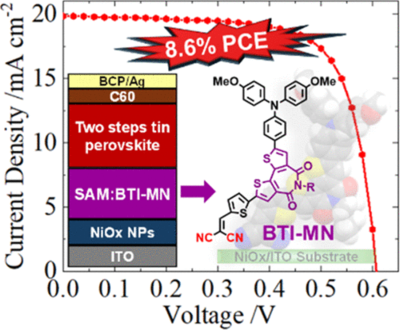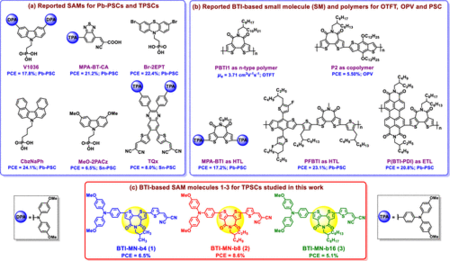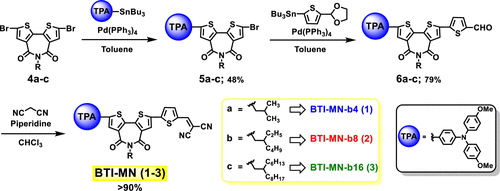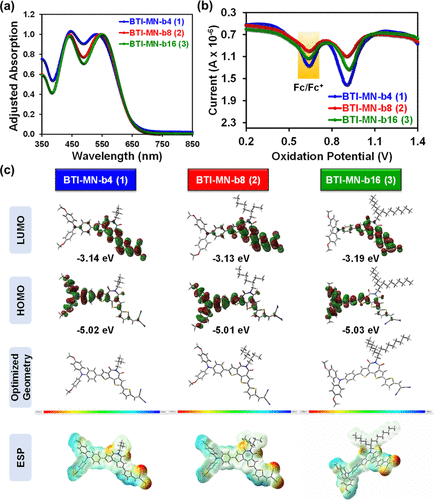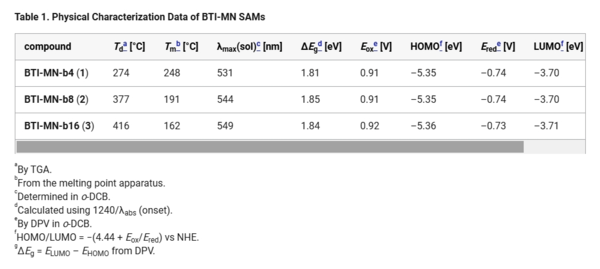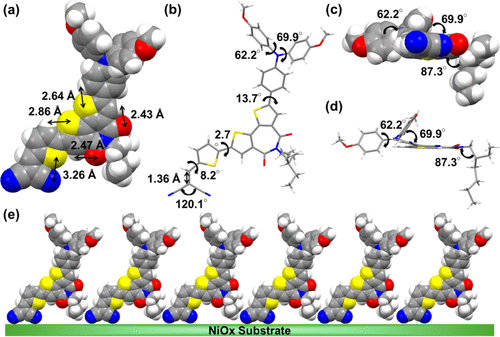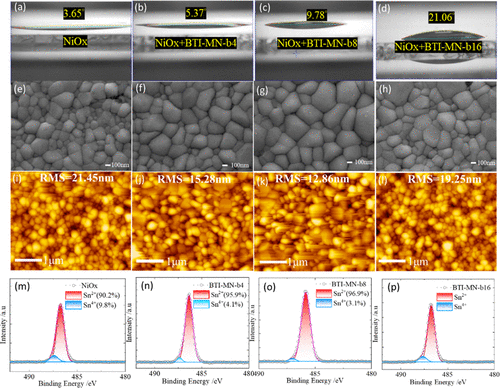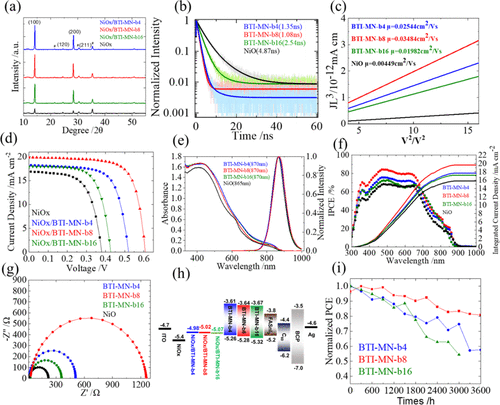NYCU刁維光組ACS:高性能錫基鈣鈦礦太陽能電池,通過在NiOx上應用二噻吩酰亞胺自組裝單層實現發表時間:2024-12-31 10:44
三種基于二噻吩酰亞胺(BTI)的新型有機小分子——BTI-MN-b4(1)、BTI-MN-b8(2)和BTI-MN-b16(3),它們各自擁有獨特的烷基側鏈,并被精心設計以用作錫基鈣鈦礦太陽能電池(TPSCs)中NiOx薄膜上的自組裝單層(SAMs)。這些SAM分子在構建高質量的TPSC鈣鈦礦層中發揮著不可或缺的作用。 NYCU 刁維光(Eric Wei-Guang Diau)教授及其團隊,通過密度泛函理論(DFT)計算,深入剖析了這些分子的結構特性。具體而言,三苯胺基團巧妙地連接在BTI核心的一側,從而促進了電荷向鈣鈦礦層的有效傳輸;而氰基與噻吩單元則形成了共軛結構,連接在BTI核心的另一側,作為錨定基團與NiOx/ITO表面緊密結合,形成了強烈的相互作用。此外,NiOx在改善ITO基底性能方面展現出了顯著的效果,使得BTI-MN-b4(1)、BTI-MN-b8(2)和BTI-MN-b16(3)能夠均勻且穩定地形成SAMs。尤為重要的是,刁維光教授團隊成功解析了BTI-MN-b8(2)的單晶結構,這一重大發現不僅進一步驗證了其設計思路的合理性,也為后續的性能測試奠定了堅實的理論基礎。 在性能測試環節,刁維光教授團隊將BTI-MN-b8(2)與NiOx結合應用于TPSCs,使其**光電轉換效率(PCE)高達8.6%。這一效率顯著優于僅使用NiOx作為空穴傳輸材料(HTM)時的4.0%的PCE。更為令人振奮的是,采用NiOx/BTI-MN-b8配置的TPSC器件在歷經3600小時的長期穩定性測試后,仍保持了約80%的初始效率。這一**的長期穩定性表現,無疑為TPSCs在實際應用中的可靠性提供了強有力的支撐。 為了全面而深入地評估這些SAM分子的性能,刁維光教授團隊采用了多種表征手段,包括熱分析、光學分析、電化學分析和形態分析等。這些表征手段不僅詳盡地揭示了NiOx/SAM/鈣鈦礦薄膜的光電和光伏特性,還直觀地展示了相應器件的**性能。特別值得一提的是,BTI-MN-b8(2)分子與NiOx的結合展現出了**的光電轉換效率和長期穩定性。刁維光教授團隊的研究成果不僅驗證了其分子設計策略的**性,更為TPSC技術的未來發展帶來了革命性的突破。這一研究不僅為采用兩步法制備技術的TPSC技術發展開辟了新的方向,還為實現更高的性能和穩定性提供了切實可行的創新方法和思路,對TPSCs領域的實際應用和理論研究都具有重要意義。
Figure 1. Chemical structures of the (a) reported SAMs for Pb-PSCs and TPSCs; (b) BTI-based small molecule and polymers for OTFTs, OPVs, and PSCs; and (c) BTI-based SAM molecules 1–3 for TPSCs studied in this work.
Scheme 1. Synthetic Route to BTI-Based SAM Molecules 1–3
Figure 2. (a) UV–vis absorption spectra; (b) DPV curves; and (c) DFT-derived energy levels and electrostatic surface potential (ESP) mapping of BTI-MN compounds.
Figure 3. Single crystal structure of compound 2. (a) Top view of BTI-MN-b8 molecule with intramolecular interactions in a space-filling model; (b) top view of BTI-MN-b8 molecule with various twisted angles in stick model; (c, d) front views of BTI-MN-b8 molecule the space-filling and stick models, respectively; and (e) expected packing pattern of SAM on NiOx/ITO substrate (front view).
Figure 4. (a–d) Contact angle of SnI2 precursor on NiOx and NiOx/SAM surfaces. (e–h) SEM, (i–l) AFM, and (m–p) XPS of tin perovskites made on NiOx and NiOx/SAM surfaces.
Figure 5. (a) XRD patterns of tin perovskites on NiOx with various SAMs, as specified; (b) PL decay profiles obtained using TCSPC; (c) SCLC measurements of tin perovskites on NiOx with the various indicated SAMs; (d) J–V characteristic curves; (e) IPCE and (f) UV–vis absorption and PL spectroscopy of tin perovskites on NiOx with various SAMs, as specified; (g) EIS Nyquist plots for devices composed of tin perovskites deposited on NiOx with various SAMs, as specified; (h) energy-level diagram; and (i) long-term stability of devices containing NiOx with various SAMs, as specified. The highest-performing device, NiOx/BTI-MN-b8, achieved a PCE of 8.6%. 文獻信息: Bithiophene Imide-Based Self-Assembled Monolayers (SAMs) on NiOx for High-Performance Tin Perovskite Solar Cells Fabricated Using a Two-Step Approach
|


